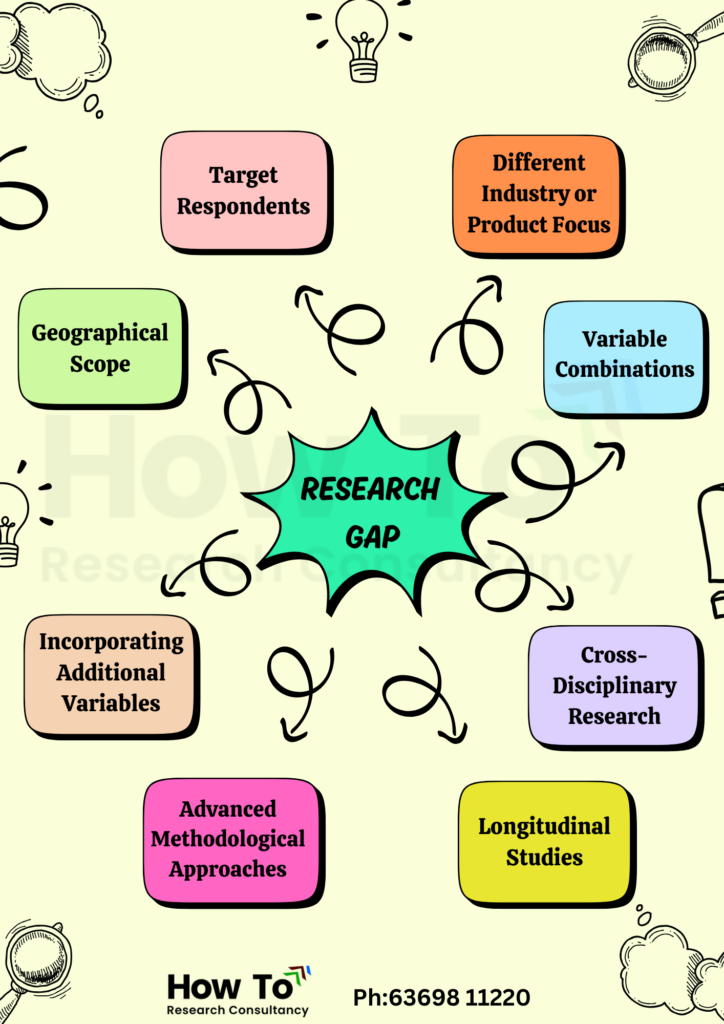Identifying a research gap is one of the most crucial steps in academic research. A research gap refers to an unexplored or underexplored area within a specific field that presents an opportunity for new investigations. Finding a research gap ensures that your study contributes new insights rather than duplicating existing knowledge. In this blog, we discuss effective strategies to identify research gaps with practical examples.
1. Reviewing Existing Literature
A comprehensive literature review is the primary method for identifying research gaps. This involves reading journal articles, conference papers, and industry reports to find areas that require further investigation.
Examples:
Digital Payment Adoption among Small Businesses: A researcher finds that existing studies predominantly focus on urban enterprises. However, there is limited research on how digital payments impact micro-businesses in rural areas, highlighting a significant research gap.
Tourism Management: While many studies focus on tourist satisfaction in luxury hotels, there is limited research on customer experience in budget accommodations, representing a gap in the literature.
Library Science: Research on digital libraries often centers on academic institutions, but there is little focus on how public libraries in rural areas adapt to digitalization.
2. Analysing Contradictory Findings
Sometimes, existing research produces conflicting results. Identifying such inconsistencies can help you formulate a research question that resolves these contradictions.
Examples:
Customer Loyalty in Online Shopping: Some studies suggest it is primarily influenced by discounts, while others argue that customer service plays a bigger role. Investigating which factor has a stronger influence in a specific context, such as personal care products, could be a valuable research gap.
Human Resource Management (HRM): Studies on “Remote Work and Employee Productivity” present conflicting findings. Some research suggests that remote work improves productivity due to flexibility, while others argue it reduces efficiency due to distractions and lack of supervision. Examining the role of organizational culture or industry type in determining the effectiveness of remote work could provide new insights into this debate.
Economics: Some studies claim that government stimulus packages significantly boost small business growth, while others argue they create short-term benefits with long-term financial burdens. Investigating sector-specific impacts could resolve these contradictions.
3. Identifying Emerging Trends and Technologies
New trends, innovations, and policies often lead to unexplored research areas. Keeping track of industry developments can help researchers discover novel topics.
Examples:
Artificial Intelligence (AI) in Healthcare: Many studies explore AI’s role in diagnostics, but there may be limited research on AI’s impact on patient trust in digital healthcare systems.
Education Technology (EdTech): While online learning platforms are widely studied, there is little research on their effectiveness in rural schools with limited internet access.
Tourism: The impact of virtual reality (VR) tourism on travel intentions remains an emerging research area, with little exploration of how VR experiences affect actual booking behaviour.
4. Studying Underrepresented Populations or Regions
Many studies focus on widely studied populations, leaving room for research on underrepresented groups or geographic regions.
Examples:
Financial Literacy and Investment Behaviour: Most research focuses on urban investors. Conducting a study on financial literacy among rural women entrepreneurs can fill an existing research gap.
Psychology: While mental health research is extensive, there is limited study on how workplace stress affects blue-collar workers compared to corporate professionals.
Library Science: There is substantial research on digital reading habits among university students, but little focus on elderly populations adapting to e-books.
5. Exploring Practical Challenges Faced by Industries
Engaging with industry professionals, practitioners, or policymakers can reveal real-world challenges that lack academic research.
Examples:
E-commerce: Platforms struggle with high return rates. While studies exist on customer satisfaction, fewer studies analyse the psychological factors behind frequent product returns. Investigating this issue can help address an industry challenge.
Management: Many studies explore employee retention strategies, but little research examines why middle management experiences higher turnover than senior leadership.
Tourism: Studies analyse destination marketing strategies, but fewer focus on how social media influencers impact last-minute travel decisions.
6. Examining Methodological Limitations in Existing Studies
Many studies acknowledge limitations in their methodologies, offering opportunities for improvement.
Examples:
Consumer Behaviour Towards Green Products: A study may have relied on surveys but lacked qualitative insights from focus groups. Conducting in-depth interviews to understand emotional motivations could provide a fresh perspective.
Education: Research on student motivation in online courses often uses self-reported data, which may be biased. Conducting observational studies could offer a more objective understanding.
Economics: Studies on income inequality rely heavily on national-level data but may not capture regional disparities. A study focusing on state-level variations could provide new insights.
7. Checking Calls for Future Research in Academic Papers
Most journal articles include a “Future Research” section that suggests unexplored areas. Reviewing these recommendations can help identify research gaps.
Examples:
Social Media Marketing and Brand Engagement: A study might suggest further research on how influencer credibility affects consumer decisions, which could be a valuable research direction.
Education: Research on student engagement in hybrid learning models might highlight the need for future studies on its impact on long-term knowledge retention.
Psychology: A study on workplace motivation may recommend further research on generational differences in motivation factors.
General Key Areas to Identify Research Gaps
Research gaps can also be found in various aspects, including:

- Target Respondents: Studying specific groups such as Millennials, Gen Z, working women, or blue-collar workers.
- Geographical Scope: Focusing on specific regions such as Chennai, Hyderabad, or Bengaluru.
- Variable Combinations: Exploring new relationships between independent, mediating, moderating, and dependent variables.
- Incorporating Additional Variables: Introducing overlooked variables to deepen analysis.
- Different Industry or Product Focus: Examining industries or products that have received limited research attention.
- Advanced Methodological Approaches: Applying multivariate statistical tools with larger samples to enhance research rigor.
- Cross-Disciplinary Research: Integrating concepts from multiple disciplines to provide novel insights.
- Longitudinal Studies: Conducting research over an extended period to analyse changes and trends.
Conclusion
Finding a research gap requires a systematic approach, including literature reviews, analysing contradictions, tracking trends, studying underrepresented groups, and consulting industry experts. By identifying gaps effectively, researchers can contribute meaningful knowledge to their fields and advance academic discourse.
Would you like a checklist or additional resources for identifying research gaps? Let us know in the comments!









Leave a Reply